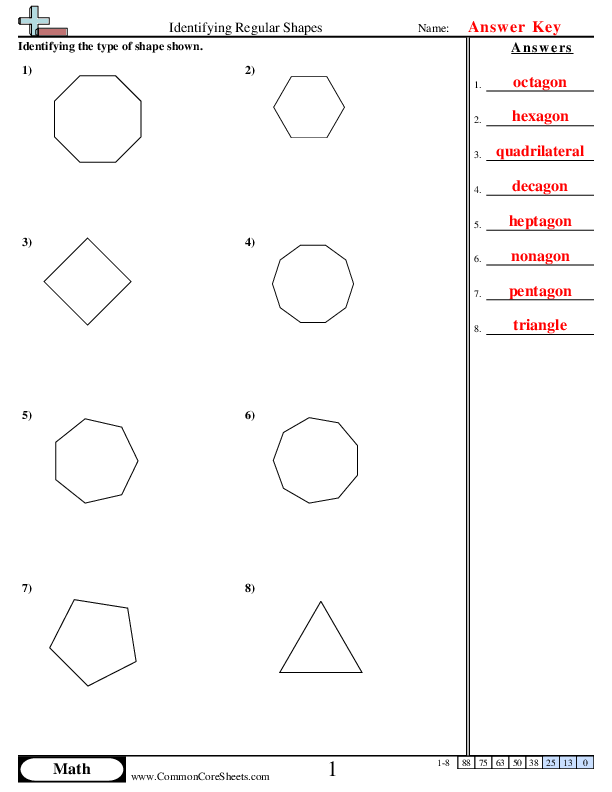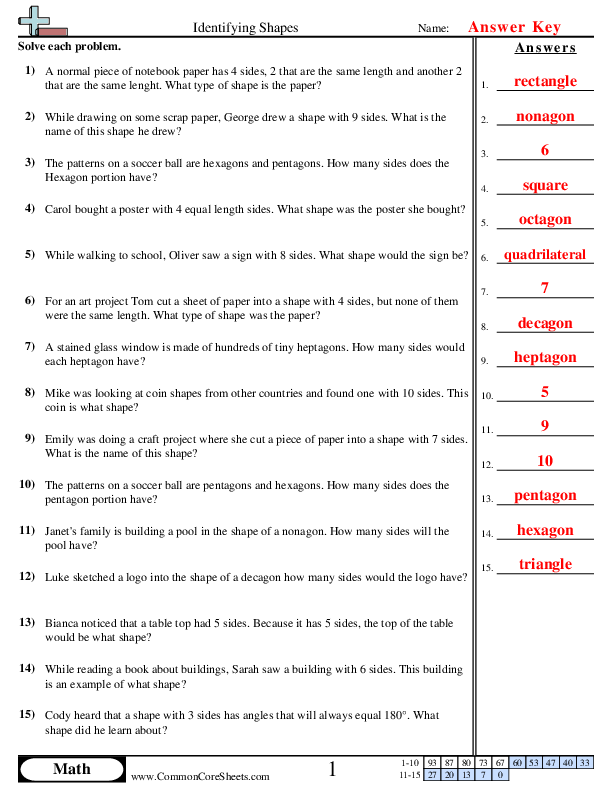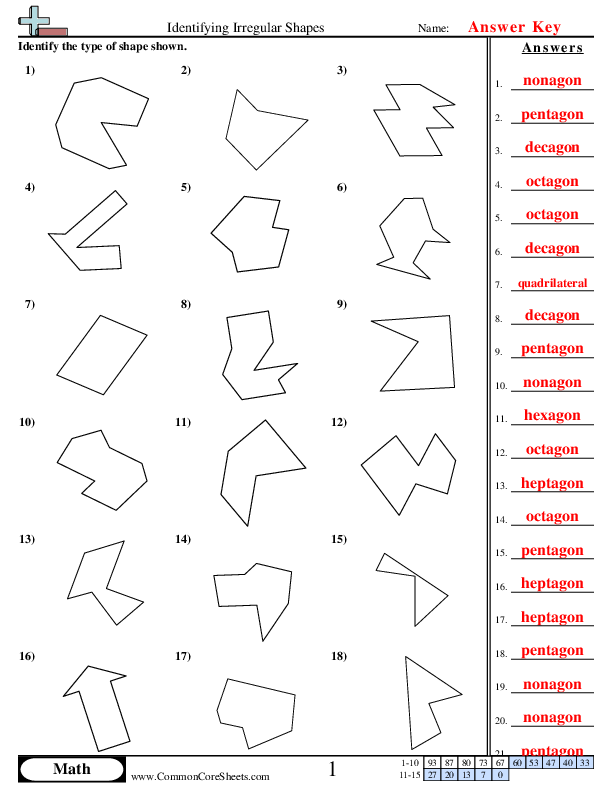Discover the best free shapes worksheets on the internet. Our worksheets help children learn about reflections, translations, the number of sides for everyday shapes and more! We have a wide variety of worksheets that include shapes ranging from basic triangles to complex hexagons and octagons. With our selection, your child can practice recognizing shapes while also learning about their properties. Our worksheets are easy to use and will help your child recognize shapes in a fun environment! With common core sheets, you can be sure you’re giving your child the best learning experience around. Try out our free shapes worksheets today!
Browse Sheets By Problem Type
×

Regular Shapes (3,4,5,6,7,8,9 & 10 sides)
3g1


×
Description:
"This worksheet is designed to facilitate children in identifying regular shapes in a playful manner. Comprising 8 interactive math problems, it encourages cognitive development through shape recognition while promoting mathematical competence. This versatile worksheet can be customized according to individual learning styles, converted into flashcards for memory enhancement, and is highly suitable for distance learning. Help your child hone critical thinking skills with this engaging math activity."

×
Student Goals:
Shape RecognitionAfter completing the Identifying Regular Shapes worksheet, students should have strengthened their ability to recognize and identify different regular shapes. They will have developed a keen eye for distinguishing between various geometric forms, an essential skill foundational to more advanced mathematical concepts.Critical ThinkingThe worksheet will enhance the child's ability to analyze and compare objects based on their shape, driving the development of critical thinking skills. By differentiating between various regular shapes, students will be exercising reasoning and critical problem-solving abilities.Mathematical KnowledgeBy navigating through this worksheet, students will reinforce their knowledge on shapes' properties and characteristics. This understanding will form a solid basis for their future engagement with complex geometric principles and mathematical operations. Further, the learned concepts can extend to many practical applications in daily life.Visual Spatial SkillsParticipating in shape identification activities like this worksheet helps students refine their visual-spatial skills. This ability is critical in interpreting the world around them including managing spatial coding and distance, important for both mathematical understanding and daily navigation.Application SkillsWith sharp skills in identifying regular shapes, students are better equipped to apply these concepts in different contexts. They should be able to identify shapes in various orientations, conditions, and composite forms, thus demonstrating an understanding of the subject beyond its theoretical aspects.Confidence In Problem-SolvingSuccessfully identifying regular shapes on the worksheet can help children build confidence in their problem-solving abilities. Undoubtedly, this confidence will not only motivate them to explore more complex aspects of mathematics but also to tackle challenges in other subjects.Vocabulary ExpansionThis worksheet would have contributed to the student's mathematical vocabulary. By consistently working through the problems, they would have become familiar with terms related to regular shapes, thereby expanding their mathematical language.



Word Problems (3 - 10 sides)
3g1


×
Description:
"This worksheet is designed to help children enhance their knowledge in math, particularly in identifying shapes based on the number of sides. Covering a range of 15 practical problems involving real-life scenarios, it encourages comprehensive geometry learning. It can be customized according to learner's needs, adapted into flash cards for more interactive learning or seamlessly integrated into distance learning programs."

×
Student Goals:
Shape RecognitionBy the end of this worksheet, students should have developed improved recognition skills for identifying various shapes by their unique characteristics, such as the number of sides each shape has. This foundational geometric understanding will prove useful across a variety of math and everyday contexts.Knowledge on Geometric PropertiesThe students are expected to be able to relate real-life objects with geometric shapes and their properties — an important step in spatial awareness. This can help them to see and understand the geometry that is embedded in our world, which could inspire them to be more creative in their thinking.Application of KnowledgeAfter successfully completing the worksheet, students should be able to apply their knowledge of shapes to practical scenarios. This could range from predicting the shape of a given object based on the number of sides described, to identifying the name of a shape by its properties. These skills can deepen their understanding of how shapes are associated with everyday items.Enhanced Problem-solving SkillsThe worksheet will help to enhance problem-solving skills. By relating shapes based on the number of sides, students are required to recall and apply geometric knowledge to solve various problems. This is a fundamental skill in mathematics that also applies in complex problem-solving scenarios.Vocabulary EnhancementPost completion, students are expected to have an extended vocabulary of specific geometric terms such as heptagon, nonagon, decagon, etc. This can enhance their communication skills especially when it comes to expressing mathematical concepts and ideas. Overall, this facilitates in making them confident in using geometry-specific terminologies in their academic pursuits as well as everyday interactions.Increased Critical ThinkingThe worksheet significantly contributes to enhancing the students' ability to critically analyze and come up with viable results. This ability will prove helpful in numerical and spatial reasoning, arming learners with the necessary skills for more advanced geometric studies. Hence, students can develop a keen eye for details which is key for solving mathematical problems.



Identifying Regular and Irregular Polygons
3g1


×
Description:
"This worksheet is designed to boost math skills by facilitating the identification of regular and irregular shapes. It contains 15 challenging problems that reinforce geometric recognition. Flexible and versatile, this resource can be customized to suit individual learning preferences, transformed into practical flashcards or effortlessly included in distance learning. Encouraging active learning, it forms a perfect foundation for understanding critical geometry concepts."

×
Student Goals:
Understanding ShapesOnce the worksheet is completed, students should have a solid grasp on the differentiation between regular and irregular shapes. This includes understanding the traits that differentiate these two shape categories and being able to confidently classify a variety of shapes independently.Developed Observational SkillsThe practice problems on this worksheet help students to hone their observational skills as they carefully examine each shape to determine its classification. By closely observing each shape's attributes, students further develop these important cognitive skills necessary not just in mathematics but in other academic disciplines as well.Improved Mathematical VocabularyBy labeling shapes as either regular or irregular, students expand their mathematical vocabulary. Understanding and using these terms correctly helps students to internally organize their understanding of shape categories and sets a solid foundation for future geometric studies.Mastery of Fundamental Math ConceptAfter completing this worksheet successfully, students can be confident they have mastered a fundamental math concept that is prerequisite for higher-level geometric studies. They’ll be equipped with the necessary knowledge to face more complex geometric problems in the future.Preparedness for Real-world ApplicationThe ability to identify and differentiate shapes is not only a mathematical skill, but also has great importance in real-world contexts. From architecture to art and design, a strong grasp of shapes and their properties prepares students for applying their learned knowledge beyond the classroom.Improved Problem-solving AbilityThis worksheet also guides the students to enhance their problem-solving abilities. By working through each problem and deciding whether a shape is regular or irregular, they get to engage in logical reasoning and decision-making processes, thereby improving their overall thinking skills.Promote Active LearningThrough completing this worksheet, students engage in active learning as they are not merely receiving information, but are processing and recalling it to solve problems. This encourages better retention and a deeper understanding of the concept.





